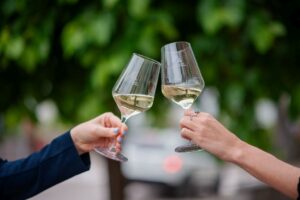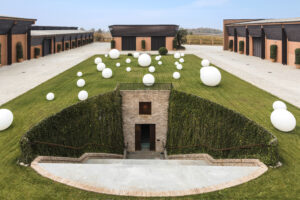The days of Grandi Langhe, the event signed by the Consortium for the Protection of Barolo Barbaresco Alba Langhe and Dogliani, together with the Consortium for the Protection of Roero, are coming with the awareness that the 2018 harvest will exceed expectations. On 28 and 29 January in Alba, in the heart of the UNESCO World Heritage area, the Consortium will expect journalists and buyers from all over the world to preview the new vintages of Barolo (2015), Barbaresco (2016), Roero (2016) and the Doc Langhe. The wines ready to enter in the wine industry, therefore, while the data and analysis show a very balanced year 2018, up 5% in volume over 2017, with a quantity of over 62.5 million potential bottles, overall, with wines that, given the weather and the first post-harvest evaluations, should express harmony and elegance.
However, it is interesting to analyze the data on production and on the surfaces of the entire territory, provided by the Consorzio del Barolo. For the new vintages of Barolo and Barbaresco, previewed at Grandi Langhe, there is a production potential of over 14 million bottles for Barolo 2015 and more than 4.5 million bottles of Barbaresco 2016. For the year 2018, however, we are talking about 14.1 million bottles of Barolo, 4.7 million bottles of Barbaresco, but also 16.3 million bottles of Langhe Doc, 12 million bottles of Barbera dʼAlba, 6.5 million bottles of Dolcetto dʼAlba, 4.6 million bottles of Nebbiolo dʼAlba, 2.8 million bottles of Dogliani, 982.949 Dolcetto di Diano dʼAlba and 159,040 Verduno Pelaverga, for a total of 62.5 million bottles, up from 59.2 million in 2017. The production data is also linked to seasonal circumstances, to the climate and even more interesting is the data related to the hectares of vineyards with a denomination. Overall, in the Langhe, there are 9,574, out of 9,105 in 2008, and all the most prestigious PDOs are growing, Barolo, for example, has been increasing for a decade, and today it is on 2,149 hectares, compared to 1,797 in 2008. A significant increase, if we consider that today, one hectare of Barolo, according to estimates collected by WineNews, has a value of around 1.2 million euros per hectare (which reaches 2.5 in the most important crus).
Barbaresco also grew, to 763 hectares in 2018, compared to 700 in 2008. Over the decade, the vineyards destined for the Langhe DOC also grew from 1,090 to 1,905, as did the Nebbiolo dʼAlba, which rose from 700 to 949 hectares, and the Verduno Pelaverga, from 17 to 22 hectares. Dogliani (from 1,055 hectares to 846), Dolcetto di Diano dʼAlba (from 292 to 236 hectares), and Dolcetto dʼAlba (from 1,645 to 1,092 hectares) are in decline. The surface area of Barbera dʼAlba also fell in 2008, from 1,809 hectares to 1,610, but with a clear reversal of the trend from 2015, when the claimed hectares were 1,561.
Numbers that tell of a wide and varied territory, which focuses more and more on its most prestigious and most valuable economic productions. All of them will be told in the glass together, in Alba, capital of great wine and white truffle, where the exhibition spaces (Palazzo Mostre e Congressi, Piazza Medford), with 206 wineries and over 600 specialized operators and journalists from more than 20 countries, will be divided according to the municipalities of origin of the wineries, an orderly territorial division, to allow participants to appreciate the variety of products and fully grasp the value of the Additional Geographical Mentions of Barolo, Barbaresco, Roero, and Diano.
Grandi Langhe is also an opportunity for the Consortium for the Protection of Barolo Barbaresco Alba Langhe Dogliani to introduce the new communication campaign focused on the enhancement of its historical activities - i.e. the protection of the brand and the management of the denominations - but also on the promotional aspect of the territory and its winemaking realities: “an activity that will be consolidated during 2019 and beyond - announced Matteo Ascheri, president of the Consortium - and there will be important news that we will present in the coming months and that concerns above all the internationalization and promotion to the final consumer”.
Focus - The 2018 harvest in the Langhe region
The 2018 vintage opened with a long, rainy winter that re-established the soil’s water supply, which had weakened due to the climatic trend of the previous year. The winter season lasted until the beginning of March with temperatures below the average of recent years, leading to a slow and gradual vegetative recovery of the vine, which was completed at the end of the month. The germination was uniform without the problems of late frosts. Spring continued to be marked by what was observed at the end of the winter, with frequent rainfall and low temperatures, leading us to expect a vintage that would develop according to ‘classic’ times and, in any case, not as early as the previous one; forecasts that were then confirmed by the continuation of the season. Between the end of May and the beginning of June in our wine-growing area, there was a period characterized by the storm that led to heavy rains, which created some difficulties for the winemakers from the point of view of vineyard management. Some fungal diseases have arisen in the areas where immediate action was not possible. The flowering and the subsequent fruit set took place regularly and under optimal climatic conditions, with the result of an abundant harvest. It was necessary to intervene with thinning operations for almost all the vines aimed at containing the product within the limits set by the individual production regulations.
The development of the summer season has been gradual and starting from the middle of July the temperatures have risen significantly. These, accompanied by a long period of good stable weather, have favored the maturation of the grapes without however leading to advances on the timing related to the harvest forecast.
Harvesting began in September for grapes destined for sparkling wines and then continued with the harvesting of the other white grapes until about the 20th of September. The data currently available indicate an estimated alcohol content that is not excessive, which, combined with a sufficiently high acidity content, ensures good support for the aromatic properties of the berries.
Dolcetto was the first black grape variety to be harvested and has an average sugar content, while the acidity levels are lower than in recent years, even if the pH in the must is maintained at normal levels. This is mainly due to the ratio between the two main acid components, in fact, malic acid has deteriorated, thanks to the high daytime temperatures of late August and early September, while tartaric acid formed at the beginning of the season when the lower temperatures favored its synthesis, has been kept in the berries in good concentration. This phenomenon has also been observed on other black-berry varieties that ripen later. Barbera is characterized by a good state of health despite presenting a certain heterogeneity between vineyards due mainly to a load of production, in which the latter was more abundant the management of the vineyard was more complex and even the parameters related to maturation were affected, recording lower data than those with lower production.
September had a favorable climatic condition, contributing to the quality of the wines obtained from the vines with a medium-long vegetative cycle. The Nebbiolo, in fact, was ready on a right timing, at the beginning of October, and the harvest lasted about three weeks.
Unlike the other varieties, the production load was limited with some situations that saw parts of the vineyard with a few bunches, a phenomenon essentially due to the climatic trend of the previous year, especially the abnormal heat recorded in the period during which the transformation of the fruit buds occurs.
In both the Barolo and Barbaresco areas, sugar levels increased in the last period of the season and it was possible to see an acceleration in phenolic ripeness, which allowed the grapes to be harvested with excellent parameters.
All this, combined with an ideal level of acidity, will make it possible to obtain harmonious wines with an excellent predisposition to aging. In conclusion, we can say that it was a traditional vintage that required the attention of the winemakers in the management of the vineyard, allowing us to obtain better results than expected at the beginning of the campaign.
Copyright © 2000/2025
Contatti: info@winenews.it
Seguici anche su Twitter: @WineNewsIt
Seguici anche su Facebook: @winenewsit
Questo articolo è tratto dall'archivio di WineNews - Tutti i diritti riservati - Copyright © 2000/2025








































































































































































































